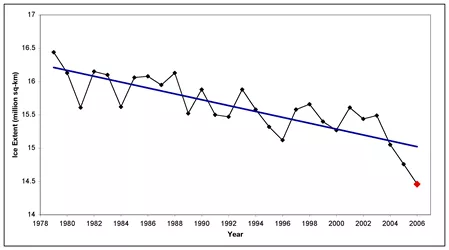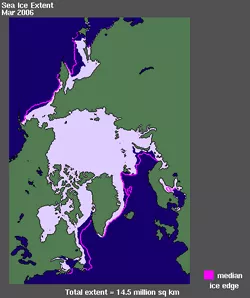Scientists at NSIDC announced that March 2006 shows the lowest Arctic winter sea ice extent since the beginning of the satellite record in 1979 (see Figures 1 and 2). Sea ice extent, or the area of ocean that is covered by at least 15 percent ice, was 14.5 million square kilometers (5.60 million square miles) for this March, as compared to 14.8 million square kilometers (5.72 million square miles) for March 2005, the previous record.
The Arctic sea ice shrinks during the summer and grows, or recovers, during the winter. The ice reaches its maximum extent during March, with a long-term (1979-2000) monthly mean extent of 15.7 million square kilometers (6.06 million square miles). Winter sea ice extent has begun to show a significant downward trend over the past four years.
However, the winter recovery trend is not as striking as the sea ice minimum trend. Changes in the sea ice minimum extent are especially important because more of the sun's energy reaches Earth's surface during the Arctic summer than during the Arctic winter. Sea ice reflects much of the sun's radiation back into space, whereas dark ice-free ocean water absorbs more of the sun's energy. So, reduced sea ice during the sunnier summer months has more of an impact on the Arctic's overall energy balance than reduced ice in the winter.
The lower winter extents are still important, however, because they reflect the pattern of reduced sea ice that scientists have already seen. Low winter recovery means that the ice is freezing up later in the fall and growing at a slower pace in the winter.

